JVC XIVIEW LT-32WX50 32in LED LCD Screen Review
JVC XIVIEW LT-32WX50 32in LED LCD Screen
A screen clearly aimed at custom installers, but is it worth the outlay?
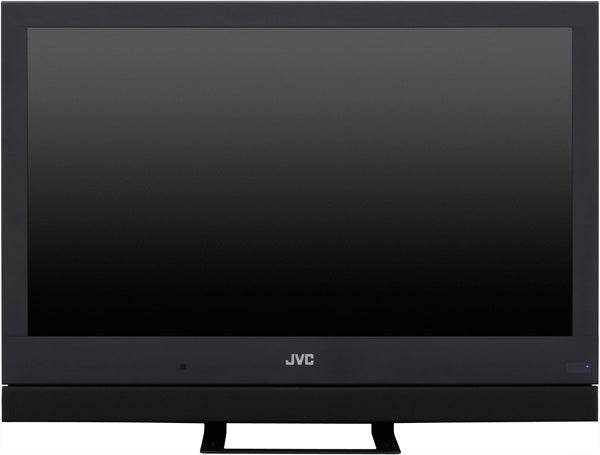
Verdict
Key Specifications
- Review Price: £2500.00
As I began unpacking and setting up JVC’s LT-32WX50 LCD screen, a rather sobering thought occurred to me. Namely, that this was the first screen I’d managed to get in for review from once-prolific brand JVC since July last year.
What’s even more sobering about this fact is that the lack of JVC screens isn’t merely down to some sleepiness in the company’s marketing department, or me just not chasing new JVC screens down.
The simple fact of the matter is that the 32WX50 is the only new screen JVC has launched in the UK since last summer. This surely speaks volumes about just how much JVC has suffered during the recession. 
What’s more, the 32WX50’s product focus in some ways reinforces this sense of JVC’s current woes. Not because it’s rubbish (though it’s certainly no classic), but simply because of what it is: a 32in LCD screen costing the frankly extraordinary amount of £2,500.
Once your eyes have stopped watering, you’ll probably realise that its price means the 32WX50 is not likely to be finding shelf space down at your local Comet or Currys any time soon. And this is actually the key point about the 32WX50. For JVC has boldy/desperately taken the decision to shift its screen business in one fell swoop from the relatively cheap end of the mass market to the pricey stratosphere of the niche custom installation market.
In some ways, this isn’t quite the crackpot idea it might initially appear. After all, JVC already has a hand ‘in’ with custom install folk courtesy of its excellent D-ILA front projectors. What’s more, there’s actually quite a gap in the market for a top premium TV designed with custom installation in mind; rival installation models are generally focussed on kitchen or bathroom situations.
Finally, of course, targeting a premium market allows JVC to build a little margin into its screen business – something that it clearly believes it can’t achieve by embroiling itself among the current carnage of the mass TV market.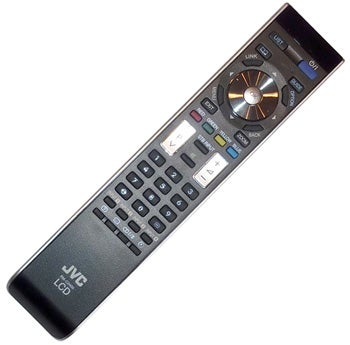
The catch, of course, is that if you’re going to charge so much for a 32in screen and target such a premium customer, you really need to have one heck of a product. And much as I might wish that JVC had managed to pull this part of the deal off, sadly it hasn’t.
Not that any problems are obvious from the 32WX50’s exterior. The screen enjoys precisely the sort of jaw-dropping design chutzpah that a truly premium product needs these days. It’s finished, for instance, in a wonderfully cold, gorgeously clinical and terrifically robust sheet of dark grey aluminium.
It also makes a point of showing you that it takes its sound duties seriously, by including a separate speaker ‘bar’ that attaches simply and elegantly along the bottom edge of the aluminium bezel.
There’s a fabulously robust and minimalist table-top stand available too, in the unlikely event that you don’t want to wall mount the screen. But somehow, I think you will want to wall mount it. For easily the most startling aspect of the 32WX50’s design is its sub-7mm depth. In other words, turn the 32WX50 side on, and for the majority of its height it’s roughly the same depth as a pencil.
This really is a remarkable achievement for JVC, and one that reminds you with a jolt that JVC can still produce cutting-edge stuff, however impoverished its current situation.
The more observant of you might have clocked from our pictures that the 32WX50 doesn’t quite retain a sub-7mm profile for its entire rear end. A section at the bottom sticks out a bit further, to around 25mm. But this is still a remarkably slim ‘maximum’ thickness, and somehow it’s the slimmer section that gives the screen its aesthetic signature.
You might expect that the slightly thicker section would play host to a tuner in the 32WX50. But actually, it doesn’t. It’s a monitor only, not a fully fledged TV – hence me (hopefully!) only calling it a screen thus far. This is actually typical of a custom installation product, where the 32WX50 will likely just be a single element within a wider home entertainment system complete with various external video sources.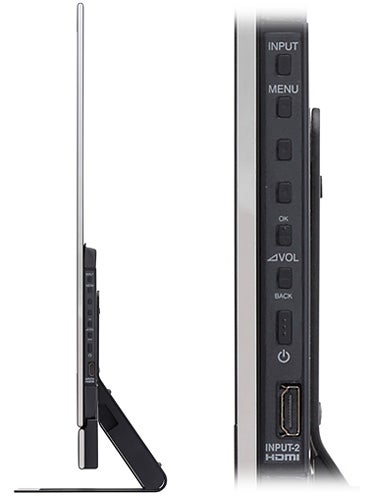
What the thicker part of the TV ”does” carry, though, is a passable selection of connections, including two HDMIs, a PC RGB input, a custom install-friendly RS-232 control port, and both USB and SD card slots for playback of JPEGs. It’s a pity, I have to say, that these latter two slots can’t also handle video files, but there you go.
You might be thinking here that a screen as expensive as the 32WX50 should have more HDMIs and an Ethernet port for, say, DLNA features, or access to online content. Built-in Wi-Fi would have raised its tech credentials and boosted its wall-hanging potential too.
But while I wouldn’t entirely disagree with you about any of these omissions, JVC can probably just about take refuge in the argument that the 32WX50’s likely status as part of a wider system relieves it of some of its multimedia burdens. Still, the screen clearly needs to have something about it to justify its cost other than its installation-friendly slimness. So it’s a relief to find it sporting JVC’s latest, updated DynaPix HD video processing system. 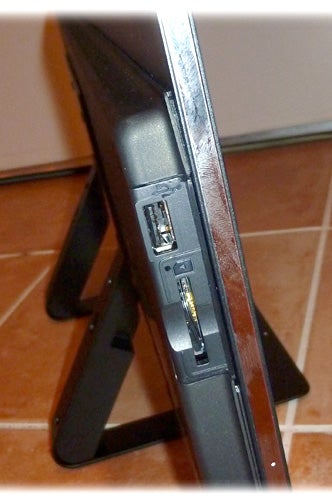
Particularly interesting to me in this system is a new Chromaticity Point Conversion Circuit – a rather complicated sounding system for tackling the drifting and bleeding when it comes to colours that inevitably arises from the differences that exist between the colour spaces of video sources and LCD screens.
Also of interest is a new Intelligent Clear Noise Reduction engine, which takes the fairly basic idea of video noise reduction and ‘turns it up to 11’ by breaking the picture down into 16 different frequency areas, before continually applying noise reduction individually to those frequencies. If this isn’t enough processing for you, then the 32WX50 also boasts a 12-bit driver that turns 8-bit HD and DVD fodder into 12-bit Deep Colour signals.
And we’re not nearly done with the set’s colour talents yet, either. For the screen also supports wide colour gamuts, including the entire sRGB colourscape, and an impressive 90 per cent of the Adobe RGB gamut. This will have serious digital photographers drooling, since it should make the 32WX50 uniquely accomplished at portraying D-SLR photography.
Then there’s the screen’s Intelligent Colour Management, which figures out which objects in a picture you’re likely to be focussing on, and pushes the colours of those objects slightly harder, in much the same way your eye does when watching real-world events.
The set has processing for motion, too, in the form of JVC’s Clear Motion Drive. This combines 100Hz with a noise reduction system that specifically targets noise associated with moving objects without – it’s claimed – making those objects look soft.
The effort JVC has put into the 32WX50’s picture engine room definitely seems to go some way towards explaining/justifying the screen’s extraordinary price. But custom installers – as their name suggests – will also demand a pretty serious amount of calibration flexibility from a screen targeted directly at their needs.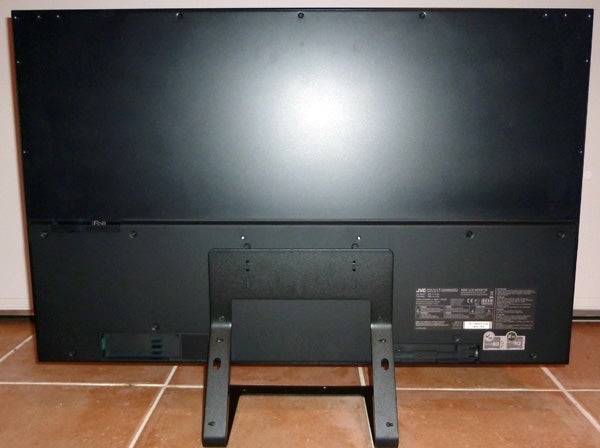
Happily JVC has learned from the harsh experience of its first, distinctly inflexible (though still great!) D-ILA projectors, and equipped the 32WX50 with a bounty of fine-tuning tools. As a small flavour of what we’re talking about, you can adjust the matrix and space of colours, as well as their core temperature; the BY gain and BY/RY angle of the hue setting; and the drive and cut-off values of the RGB colour primaries. Plus there’s a really extensive colour management system.
At first glance, after some careful and unusually – dare I say enjoyably?! – extensive calibration work, the 32WX50’s pictures look good. In fact, they sometimes look absolutely outstanding.
The chief constituent in this grand first impression is the screen’s colour response. This is to some extent predictable given how much effort JVC has put into colour reproduction. But what isn’t predictable is just what a profound difference all the processing and the wide colour gamut system actually make.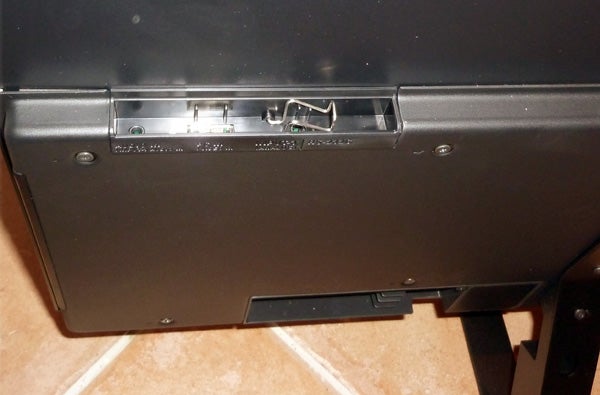
Saturations across the colour spectrum are presented with outstanding richness and dynamism, giving pictures an immediate and dramatic level of punch.
Even better, though, is the breadth of colour palette the screen can portray. This adds further to the image’s effortless sense of vibrancy, and perhaps most tellingly of all, it allows the screen to produce what are for my money the most subtle colour distinctions and blends I’ve ever seen on a flat TV.
It’s hard to describe just how much this latter point adds to pictures. The best way I can put it is that it gives objects a more three-dimensional presence (though the screen does not display actual 3D!); makes images – especially those featuring people’s faces – look more natural and ‘HD’; and finally makes high quality HD sources, especially digital photographs, look more detailed.
Talking of digital photos, the extra range of the 32WX50’s colour palette is immediately obvious to even an untrained photographic eye, as the breathtaking detailing noted a moment ago is joined by colours so natural that you’d swear you were looking through a window at a real world, rather than just ogling a high-resolution digital photograph.
Helping the 32WX50’s colours make their class-leading point is a very intense brightness for such a slender screen.
More good news finds the 32WX50’s processing stopping judder from becoming any significant distraction, and that rather unassuming-looking speaker bar producing a well-rounded, detailed and startlingly potent soundstage. In fact, the audio performance is in a different league to the sort of tinny nonsense heard with many screens much bigger and deeper than the 32WX50.
None of this chimes at all, of course, with the image quality score of 6. This, alas, is explained by an uninspiring contrast response.
The problem, as you might expect from what I’ve said before, isn’t with the bright end of the contrast spectrum. The screen does rich, pure whites and bright colours very well indeed.
Where it struggles is with the darker end of things. Particularly annoying is the pretty obvious occurrence of pools of light which spill onto all four corners of the picture when watching any night-time or dark room sequence. I always find the appearance of such backlight inconsistency seriously annoying, as it routinely distracts me from any dark sequence I want to watch. 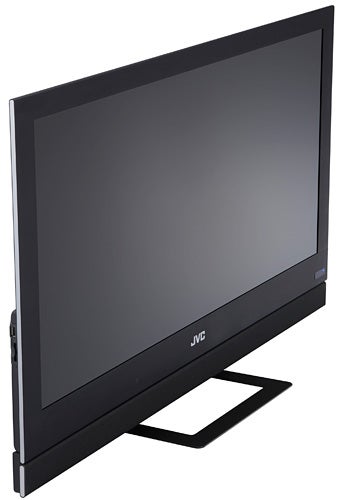
I’ve seen similar problems on a few TVs of late, and it’s really starting to bug me. In fact, with edge-LED LCD screens like this JVC seeming to be the worst culprits, I’m beginning to wonder if I’m not going to fall out with quite a few other edge LED designs before this year’s out.
The general depth of the 32WX50’s black colours is also pretty unspectacular, with obvious greyness hanging over anything that’s supposed to look black. In fact, the only really good news here is that unexpectedly, the black level response doesn’t diminish as badly as we often find with LCD screens if you watch the 32WX50 from a wide angle.
Another, perhaps more surprising weakness of the 32WX50’s pictures is their lack of sharpness. For while the colour processing does a great job of trying to boost colour detail, the detail levels the 32WX50 can produce with static or relatively static HD material are sadly damaged during typical video viewing by noticeable motion blur.
The set also proves below par at upscaling standard definition pictures, leaving them looking flat and uninvolving. This is really unexpected given the presence of JVC’s usually dependable DynaPix HD scaling engine, but I can only tell you what I’m seeing. And it isn’t good.
”’Verdict”’
I admire JVC’s guts for having the audacity to even launch a custom install product like the 32WX50. And I also admire JVC for delivering such a stunning design, for packing its screen with so much set-up flexibility, and for delivering a colour palette that actually does go beyond anything I’ve seen before on a flat screen, at least during bright scenes.
But it seems that lovely slimness has come at quite a heavy price when it comes to black level response. And the extent to which the screen’s problems with motion blur can take the snap out of HD really doesn’t seem acceptable on a £2,500 screen.
All in all, this screen is ultimately a potent reminder that adding all the bells and whistles in the world won’t save you if you don’t get the basics right.
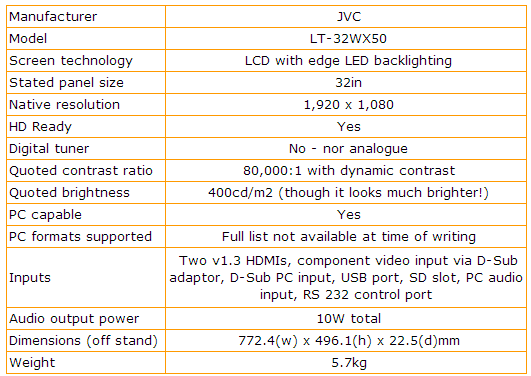
How we test televisions
We test every TV we review thoroughly over an extended period of time. We use industry standard tests to compare features properly. We’ll always tell you what we find. We never, ever, accept money to review a product.
Trusted Score
Score in detail
-
Features 9
-
Value 5
-
Image Quality 6
-
Design 9
-
Sound Quality 9
Features
| Size (Inch) | 32in |
| Display Type | LED |

